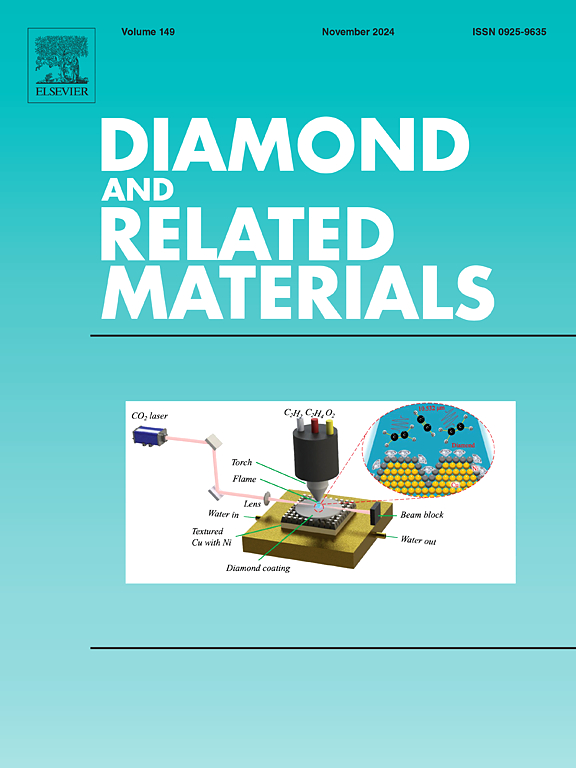基于稳态多物理场模型的4英寸金刚石膜高效MPCVD反应器设计与优化
IF 4.3
3区 材料科学
Q2 MATERIALS SCIENCE, COATINGS & FILMS
引用次数: 0
摘要
微波等离子体化学气相沉积(MPCVD)技术以其在低温操作、提高生长速度和优越的杂质控制方面的优势而闻名,已成为制造高质量金刚石薄膜的重要方法。然而,目前的MPCVD反应器仍然面临着巨大的挑战,包括沉积面积有限、微波能量利用效率低、等离子体放电不稳定等。为了应对这些挑战,本研究首先介绍了一种基于电磁模拟的混合模式MPCVD反应器,该反应器支持TM01和TM02模式,其中电磁模式叠加有助于改善衬底上方的微波电场均匀性,并允许将衬底直径增加到110 mm,用于4英寸金刚石薄膜的沉积。其次,本研究提出了一个稳态多物理场模型,该模型可以模拟MPCVD反应器内的纯氢放电,并演示了所提出的MPCVD反应器产生的4英寸等离子体球。最后,在不使用任何额外调谐器件的情况下,该多物理场模型进一步优化了MPCVD反应器的微波能量效率,达到94%以上。优化后的MPCVD反应器具有4英寸等离子体球生成能力和较高的微波能量效率,具有很大的实际应用潜力。此外,所建立的稳态氢放电多物理场模型也可用于优化其他MPCVD反应器的几何形状和操作条件。本文章由计算机程序翻译,如有差异,请以英文原文为准。
Design and optimization of a high-efficiency MPCVD reactor for 4-inch diamond film deposition based on steady-state Multiphysics modeling
Microwave plasma chemical vapor deposition (MPCVD) technique, known for its benefits in low-temperature operations, enhanced growth rates, and superior impurity control, has become a prominent method for manufacturing high-quality diamond films. Nevertheless, current MPCVD reactors continue to face significant challenges, including limited deposition area, inefficient microwave energy utilization, and plasma discharge instability. In response to these challenges, this study firstly introduces a hybrid-mode MPCVD reactor that supports both the TM01 and the TM02 modes based on electromagnetic simulations, in which the electromagnetic mode superposition helps to improve the microwave electric field uniformity above the substrate and allows to increase the substrate diameter up to 110 mm for 4-inch diamond film deposition. Secondly, this study proposes a steady-state Multiphysics model that can simulate pure hydrogen discharges within MPCVD reactors and demonstrate the 4-inch plasma sphere generation of the proposed MPCVD reactor. Finally, the microwave energy efficiency of the proposed MPCVD reactor is further optimized with this Multiphysics model to exceed 94 % without using any additional tuning devices. The 4-inch plasma sphere generation capability and the high microwave energy efficiency enable the optimized MPCVD reactor great potential for practical applications. Besides, the proposed steady-state Multiphysics model of hydrogen discharges can be also used to optimize the geometries and operation conditions other MPCVD reactors.
求助全文
通过发布文献求助,成功后即可免费获取论文全文。
去求助
来源期刊

Diamond and Related Materials
工程技术-材料科学:综合
CiteScore
6.00
自引率
14.60%
发文量
702
审稿时长
2.1 months
期刊介绍:
DRM is a leading international journal that publishes new fundamental and applied research on all forms of diamond, the integration of diamond with other advanced materials and development of technologies exploiting diamond. The synthesis, characterization and processing of single crystal diamond, polycrystalline films, nanodiamond powders and heterostructures with other advanced materials are encouraged topics for technical and review articles. In addition to diamond, the journal publishes manuscripts on the synthesis, characterization and application of other related materials including diamond-like carbons, carbon nanotubes, graphene, and boron and carbon nitrides. Articles are sought on the chemical functionalization of diamond and related materials as well as their use in electrochemistry, energy storage and conversion, chemical and biological sensing, imaging, thermal management, photonic and quantum applications, electron emission and electronic devices.
The International Conference on Diamond and Carbon Materials has evolved into the largest and most well attended forum in the field of diamond, providing a forum to showcase the latest results in the science and technology of diamond and other carbon materials such as carbon nanotubes, graphene, and diamond-like carbon. Run annually in association with Diamond and Related Materials the conference provides junior and established researchers the opportunity to exchange the latest results ranging from fundamental physical and chemical concepts to applied research focusing on the next generation carbon-based devices.
 求助内容:
求助内容: 应助结果提醒方式:
应助结果提醒方式:


